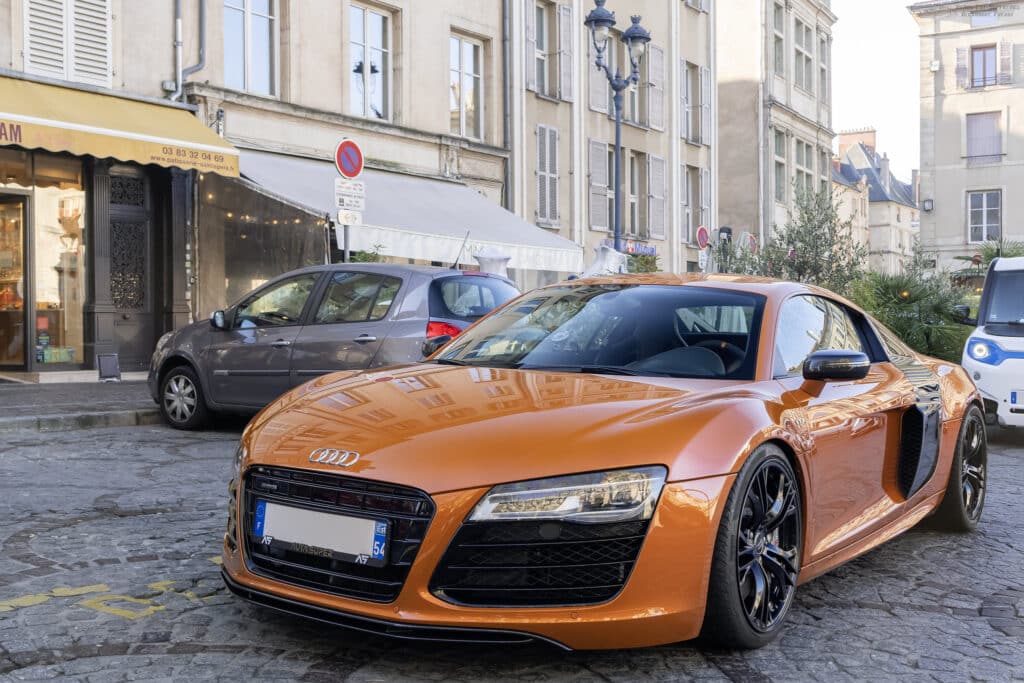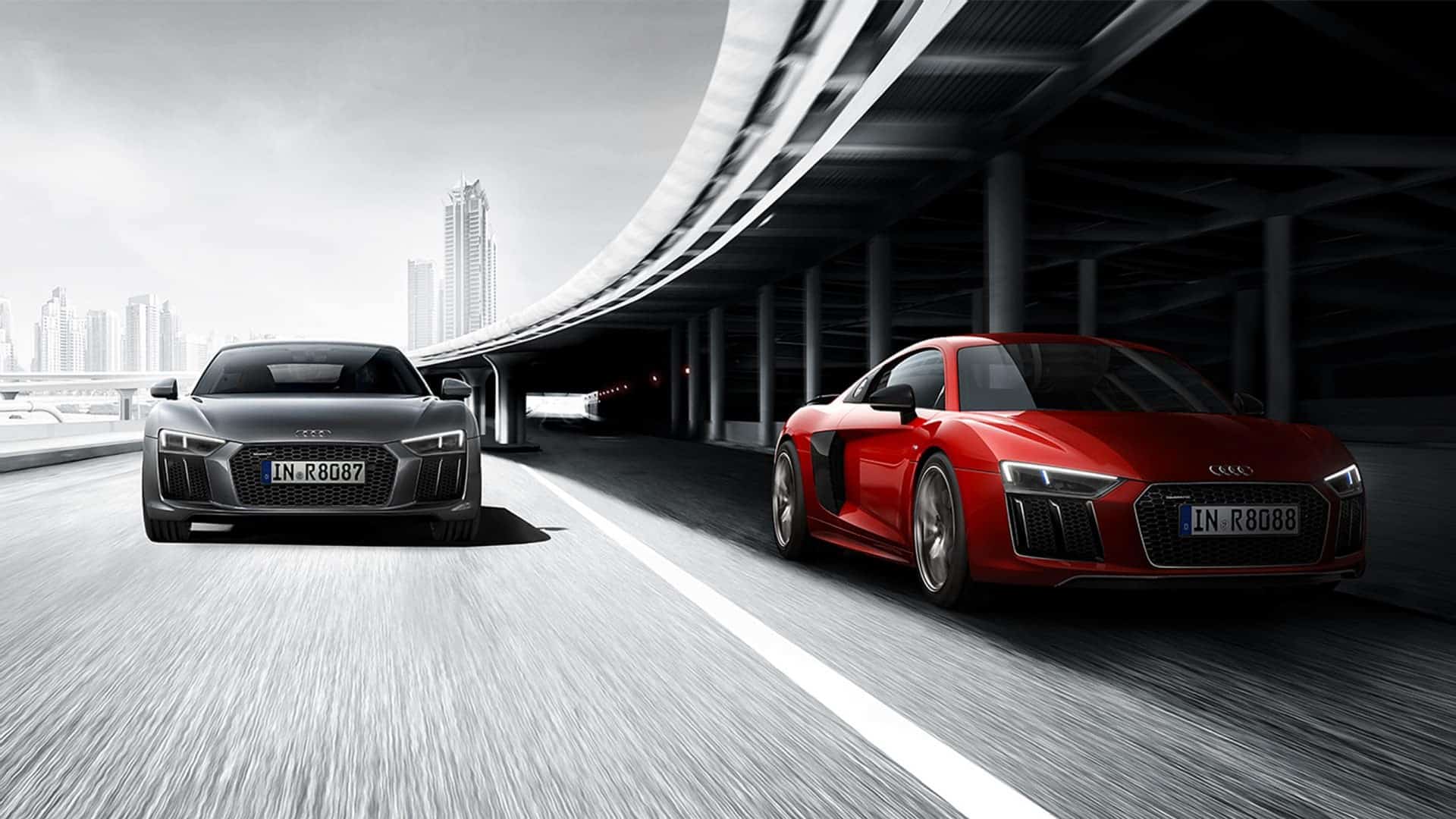Check the current auctions on the Audi R8
The recipe for an excellent super sports car is, in essence, a simple one. You take a powerful engine, bolt it into a well-balanced chassis, and wrap it up with a stunning-looking body. And on the other side, things like luggage space, practicality, or fuel economy won’t cause too much concern here. So, it’s no surprise that many car makers had their share of attempts at making one. If done right, a supercar can boost the brand’s image and turn all heads in the automotive world. But on the flip side, the competition here is fierce, and there is no room for mistakes, especially for big players. Or in other words, any car going head-to-head with Ferrari, Porsche, or McLaren must be perfect. So, let’s see how well Audi did in their attempt at this automotive segment, which is called the R8.
The idea behind the Audi R8
Audi has always been good at making a wolf in sheep’s clothing by shoving a powerful engine and elaborate drivetrains into their ordinary, slightly unamusing cars. Let’s start with the legendary Audi Quattro, which turned the world of rallying upside down. Apart from the running gear, this car shared most of its components with an Audi 80 sedan. And they’ve been doing this ever since with their powerful S and even more extreme RS range. For many, these are the best cars in their class, easily outgunning their rivals, such as BMW or Mercedes. Not only are they fast, but they are also easy to control in all real-life conditions.
In essence, all these cars are far faster than their looks would suggest. For example, the top-of-the-range RS6 doesn’t look much different from an entry-level model with a 2-liter diesel engine.
But by the early 2000s, Audi wanted to add a true sports supercar to their lineup. The basic idea was to take the well-proven mechanics, including the engine and four-wheel-drive system and put it into a sleek, lightweight 2-seater. And to ensure the perfect balance, the car would have a mid-engine setup and, consequently, only two seats.

Still, developing such a car from scratch would be extremely expensive, which could make the whole project economically unfeasible. Luckily, Audi is a part of the large Volkswagen group, which also has several other brands under its belt. And one of them is Lamborgini, who was developing a brand-new model called Gallardo. So it was decided that the Audi would use the Lambo’s new chassis as a starting point, giving it a different body and fitting their drivetrain. And the resulting model will be called the R8.
Audi R8’s first generation
The looks
Following several similarly named and shaped concepts, the first-generation Audi R8, codenamed Type 42, was revealed at the 2006 Paris Auto Show. And despite sharing the platform and most of the mechanical underpinnings with the Lamborgini Gallardo, these two cars had no visual similarities. While the Italian car was aggressive and flashy, the German boosted a more subtle and sustained design. But the R8 was entirely different from the rest of the Audi range, with front-end fascia, which loosely resembled the TT, being the only similarity.
This included an unmistakable Audi-shaped grille and headlights with LED-strip used as Daytime Running Lights. With a low-hanging hood and sloping rear end, the R8’s silhouette was determined by its mid-engine configuration. The side figure was dominated by uniquely shaped air vents, which Audi called sideblades. These could be painted differently from the rest of the car, which was the most popular choice and quickly became R8’s trademark feature. On the back, sleek tail lights were accompanied by large air vents and chromed exhaust pipes.

Initially, the R8 was only available as a 2-door coupe, with – predictably for a car of this sort – only two seats. Later on, in 2008, a Spyder version with a retractable soft-top was introduced. This version had its unofficial revival in the hugely-popular Iron Mad 2 movie, where it was first seen by the public. Apart from the absence of the metal roof, the Spyder didn’t have recognizable sideblade air vents, and the fuel door was moved to a lower position. Other than that, the two cars were virtually identical. Lastly, the R8 was mostly made from aluminum, while some body panels were carbon fiber, which helped reduce the weight.
The mechanics
When it was introduced, the R8 had a 4.2-liter V8 FSI engine borrowed from a then-current RS4 sedan. Some key features included direct fuel injection, variable valve timing, and a race-style dry sump, among other things. Thanks to this, the engine developed 414 horsepower and 430 Nm of torque. With it, the R8 would accelerate from 0-60 in approximately 4 seconds and had a top speed of 187 mph. The other engine was similarly designed 5.2-liter V10, which was initially developed by Audi to be used in Lamborgini Gallardo. With it, the power output increased to 525 horsepower and 530 Nm of torque, which improved acceleration and top speed.

Initially, two transmission options – a traditional manual and an automated variant, both of which had six speeds – were available. Later, a more reliable and easy-to-use 7-speed automatic with dual-clutch technology was added. All cars were equipped with Audi’s Quattro four-wheel-drive system, which ensured superior grip in all weather conditions. This configuration would excel on slippery roads, where it could put down the power more efficiently than its rear-wheel-drive rivals. But the power delivery in R8 was strongly biased to the rear, giving it an oversteering tendency when pushed to the limit. Still, this was easily controllable, making the car agile and precise through fast and tight corners.
The second generation of the Audi R8
After the first generation of Audi’s supercar had been around for nine years, its successor was finally introduced in 2015. The new R8, codenamed 4S, was completely reworked from the ground up and shared the platform with Lamborghini Huracán. But despite this, its overall shape and design haven’t changed significantly, which wasn’t a surprise, given how well the original car was received. The most notable differences were the recognizable sideblades, now split in two. Again, the R8 was available as a 2-door coupe or a soft-top convertible. And while the body remained very similar to its predecessor, the chassis received a significant upgrade. This included the widespread use of carbon fiber instead of aluminum, which stiffened it up while reducing weight.

As with the looks, there were no dramatic changes underneath the aluminum-carbon fiber body. The 4.2-liter V8 was dropped from the lineup, with a well-known 5.2-liter V10 now being the only option. Although this engine was carried over from the previous R8 generation, it was thoroughly revised, upping the power output, which ranged from 540 to 610 horsepower. A manual transmission wasn’t available in the second-generation R8, which only came with a 7-speed dual-clutch automatic. Again, the Quattro four-wheel-drive was standard, although this car could also be ordered with a rear-wheel drive only. This reduced weight and complexity but at the expense of grip in slippery conditions. Still, the rear-wheel-drive R8 could be faster on dry tarmac than its Quattro sibling, especially when driven by an experienced driver.
How much does a used Audi R8 cost today?
Like with most other cars, the price of a used Audi R8 differs depending on several factors. This includes the year of production, which engine it has, and its general condition, among other things. With that in mind, you can find an early V8 model for less than 70,000 €, while a fully-loaded V10 with an automatic transmission could cost twice as much.
The summary of the Audi R8
The Audi R8 is a 2-door sports car made since 2006, with its second generation being introduced in 2015. During all this time, they were offered as a coupe or a soft-top convertible. Initially, the R8 was available with a V8 or V10 engine mated to a manual or automatic transmission, with four-wheel-drive as standard. The second-generation cars, though, had only V10 engines and automatic transmissions.





